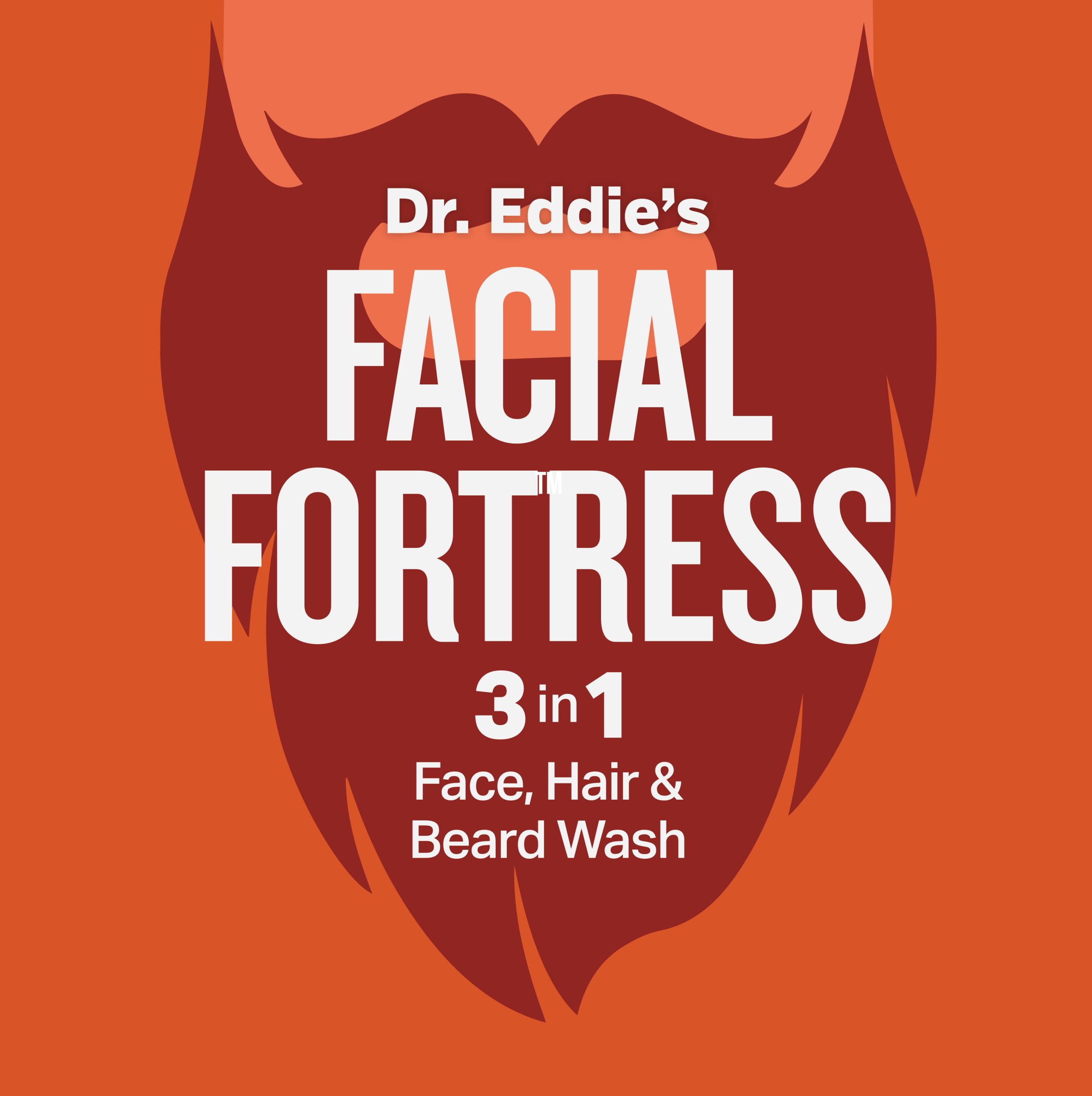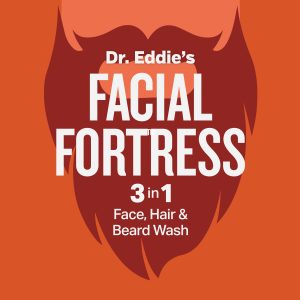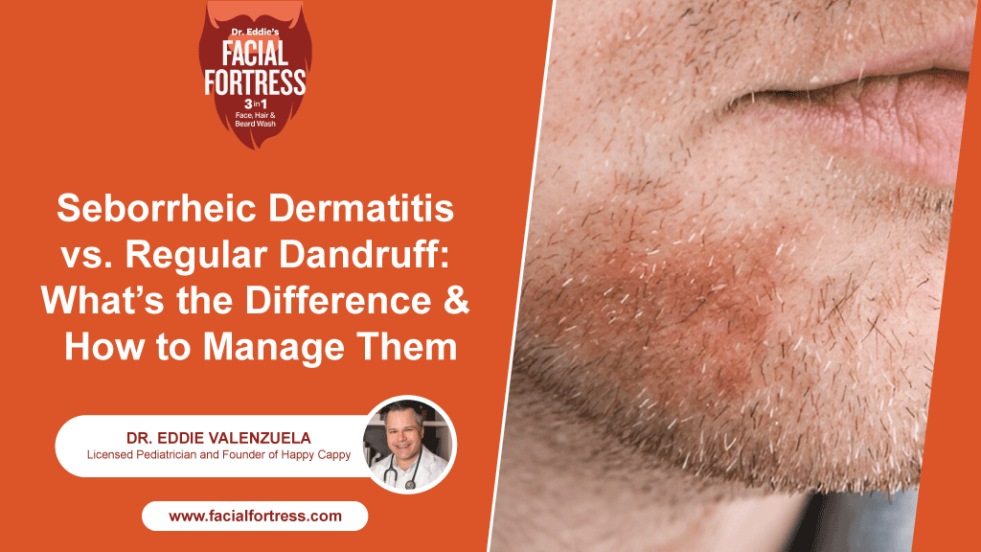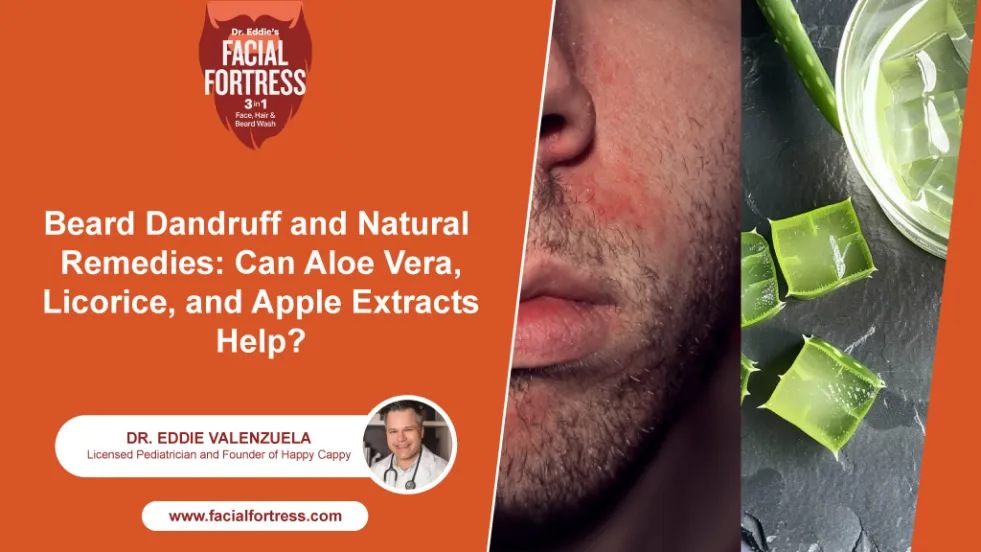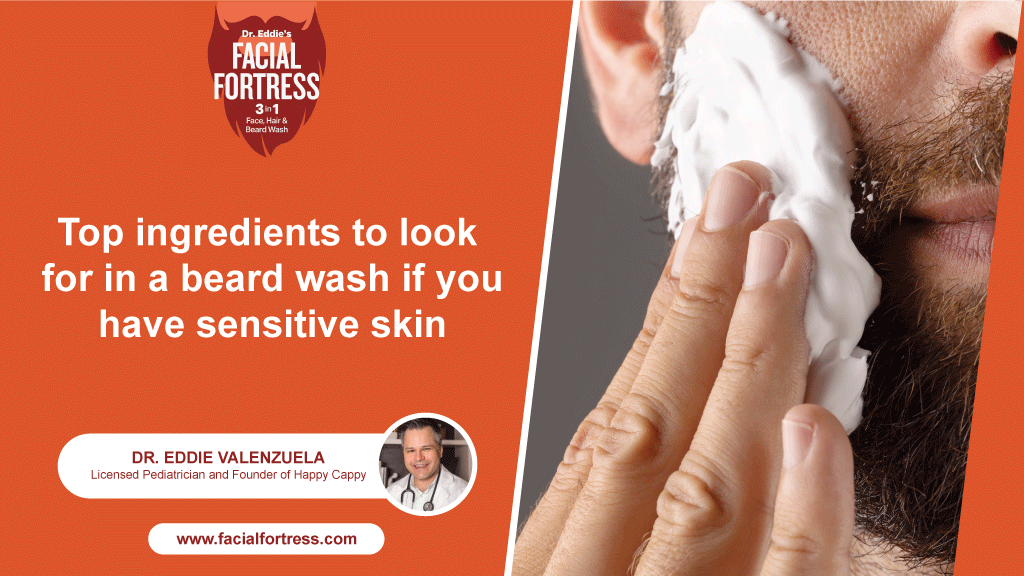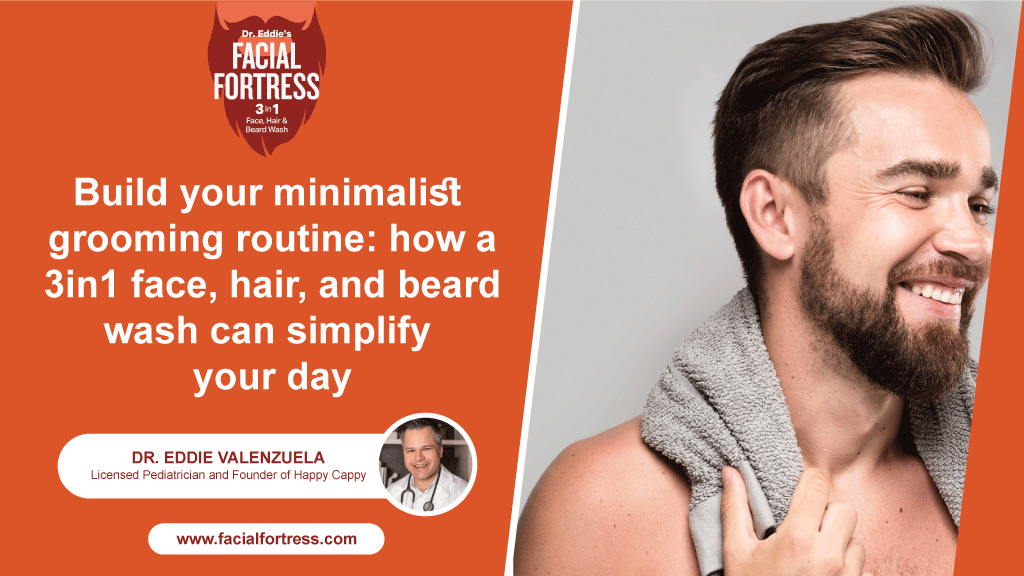Can You Get Dandruff on Your Face? Causes, Symptoms & Effective Treatments
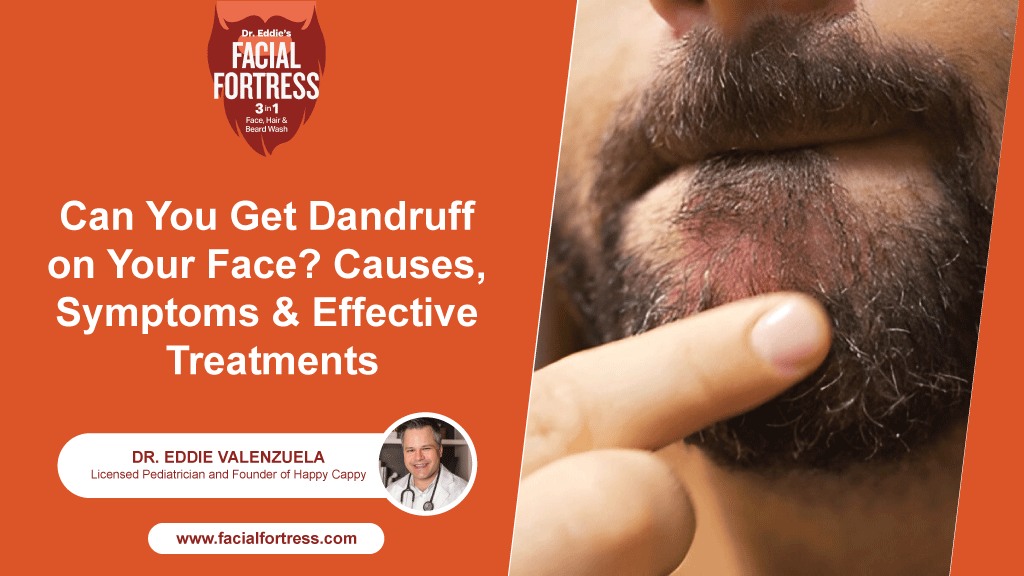
Dandruff happens on your scalp. You may also notice flakes behind the ears, but can you get dandruff on your face? That’s a question worth asking, and we will provide a detailed answer within this article.
The short answer is yes, you can get dandruff on your face. So, what should you do to identify it and how to get rid of face dandruff? Read this guide from start to finish to get a clearer understanding.
Can You Get Dandruff on Your Face?
Yes, you can get dandruff on your face. When it occurs on the face, it is referred to as Facial Dandruff. This condition itself is not harmful, but it can be uncomfortable. Facial Dandruff is less common than scalp dandruff.
Facial dandruff is the common name for seborrheic dermatitis when it appears on the face. While people often call it dandruff, true dandruff is a non-inflammatory condition. Seborrheic dermatitis, by contrast, is an inflammatory skin disorder that can affect both children and adults and may appear on many areas of the body.
In facial dandruff, the face exhibits symptoms of seborrheic dermatitis, such as redness, irritation, itching, greasy patches, and the skin becomes more oily. The areas of the face that are most affected include:
- Creases that run along the sides of the nose where it attaches to the rest of the face (alar grooves)
- Eyebrows and the space between the eyebrows (known as the glabella)
- Beard area (mustache, cheeks, and chin).
All areas of the face can be affected, but those with more oil production are likely to develop more flakes. The flakes and irritation can lead to temporary changes in skin color which can negatively affect how you feel about yourself.
Some people worry that others avoid them, thinking facial dandruff might be contagious. The good news is it’s not contagious, and we’ll share tips to help improve its appearance.
Causes of Dandruff on Face
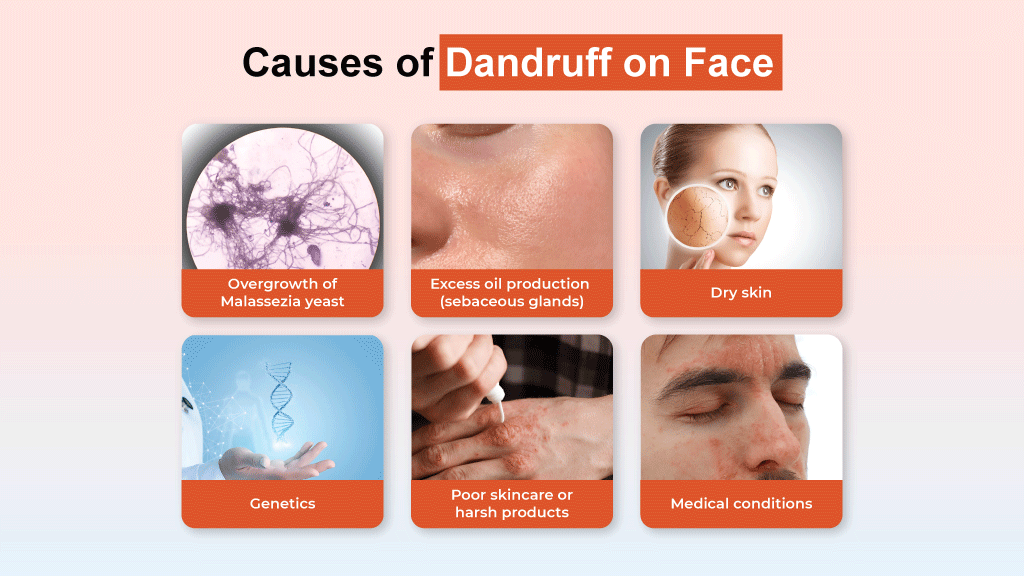
If you are wondering why my face has white flakes, you are not alone. The causes of facial dandruff are multifactorial, including a fungus overgrowth, certain climates, excessive oil production in the skin, and genetics.
1. Overgrowth of Malassezia yeast
One of the main causes of seborrheic dermatitis on the face and scalp is the overgrowth of a yeast, Malassezia. There is no issue with the yeast being on your skin, as it is naturally found on everyone’s body. However, its overgrowth, paired with increased sebum (oil, naturally found on skin), leads to overproduction of the irritant oleic acid and leads to shedding of skin cells. Those skin cells, when combined with excess oil, result in dandruff flake formation.
2. Excess oil production (sebaceous glands)
Excessive oil is a major factor in a flaky and greasy appearance on the face. When sebaceous glands in our body become overactive, they start producing more sebum oil. The oil itself is good and healthy for our skin and protects it, but excess sebum oil, paired with the yeast, can clog the skin pores and result in acne-like symptoms. That is why, folks often ask, Does facial dandruff cause acne? The answer is that Malassezia yeast can cause dandruff anywhere, and Malassezia yeast can also cause a condition known as fungal acne.
3. Dry skin and weather conditions
Extreme or harsh weather conditions, especially cold and dry environments, can make the skin barrier weak. When something irritating comes in contact with your skin, it can trigger an inflammatory reaction in your body.
4. Skin sensitivity and genetics
Some people have delicate and sensitive skin, which is more prone to various skin issues. Genetics also plays a role in the formation of dandruff and its recurrence. People with a family history of eczema and psoriasis are more prone to getting dandruff. The heritability may be due to increased sensitivity to Malassezia yeast.
5. Poor skincare or harsh products
Your skincare routine matters a lot. Poor hygiene, characterized by infrequent washing, can lead to dandruff on your face, acne, and other complications. Using cheap-quality cosmetic products or ones that include harsh chemicals can also worsen underlying skin conditions. This is why experts often recommend stopping the use of beauty products when dealing with a disease.
6. Medical conditions (eczema, psoriasis, weakened immunity)
Facial dandruff can be a byproduct of certain diseases. Those with a weakened immune system may be more prone to eczema. Face dandruff can coexist with eczema and psoriasis. Psoriasis occurring with seborrheic dermatitis (dandruff of the face) is referred to as sebopsoriasis.
Symptoms and Signs of Facial Dandruff
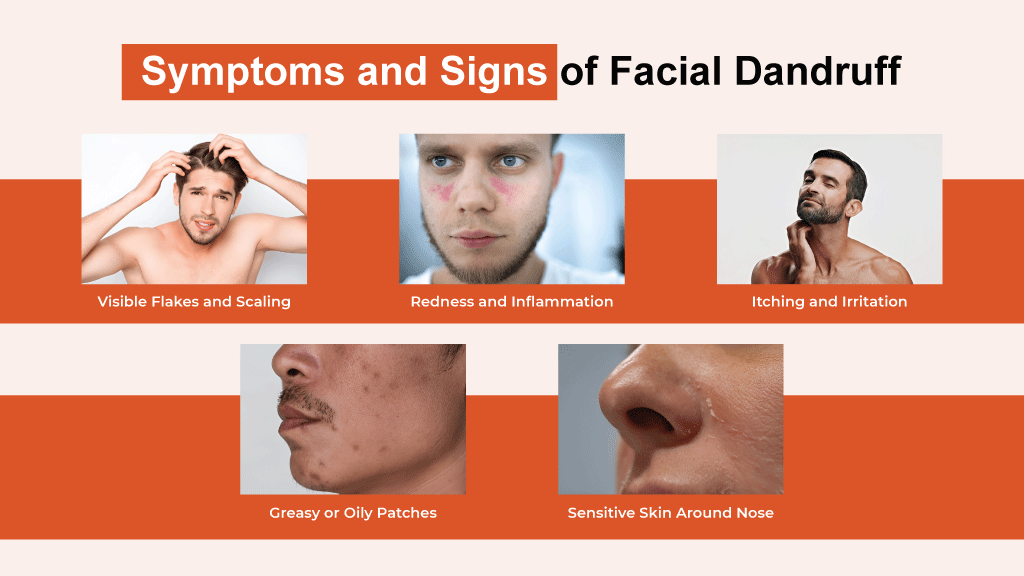
Facial dandruff can result in visible symptoms that can be bothersome enough to affect how you feel about yourself.
Visible Flakes and Scaling
The most common symptom is the occurrence of flakes. The flakes can vary in size but are typically visible to the naked eye, just like those in scalp dandruff. The flakes can be yellow or white, and they are often greasy and oily.
Redness and Inflammation
The face may become slightly red, or you may see red patches. The affected area will be irritated. Discoloration is another common symptom of facial dandruff on the face due to greasy patches. Extra oil, flakes, and inflammation, combined, can lead to a change in your face’s color.
Itching and Irritation
Itching is a common occurrence when Seborrheic Dermatitis affects your face. However, please try and avoid scratching as it can worsen the already irritated skin further.
Greasy or Oily Patches
Seborrheic Dermatitis often occurs due to excessive oil buildup. Your face will become more oily and develop greasy patches. The flakes will be oily too. Certain areas on the face, like the nose, will be more greasy.
Sensitive Skin Around Nose, Beard, and Eyebrows
Specific areas on the skin, like the nose, chin, and eyebrows, will become more sensitive. These are also areas prone to more flakiness.
How to Remove Dandruff From Face?
Facial dandruff requires anti-fungal solutions to fight the yeast and reduce its growth. The OTC products for dandruff and seborrheic dermatitis are widely available, but the best one should control the yeast growth and soothe the symptoms associated with dandruff.
- Anti-dandruff shampoo
If you see flaky dandruff in your ears, chin, nose, and all over your face, an effective way to manage this condition is by using an anti-dandruff shampoo. However, not all dandruff shampoos are made the same. We suggest using a product designed for individuals with sensitive skin. Facial Fortress is just that, a 3-in-1 wash (for face, hair, and beard dandruff) made with high-quality raw materials that are designed to avoid irritating delicate skin. This anti-dandruff shampoo for the face contains pyrithione zinc as an active ingredient, which is effective against flakiness and itching. This shampoo reduces symptoms associated with seborrheic dermatitis, such as itching, redness, scaling, and irritation on the skin.
- Sulfur and Selenium Sulfide Treatments
Products containing sulfur or selenium sulfide can help manage the itching, redness, and irritation caused by seborrheic dermatitis. Selenium sulfide shampoos are especially effective for the scalp, while sulfur-based soaps and cleansers are often better tolerated on the face and other sensitive areas. If over-the-counter options don’t provide enough relief, a dermatologist may prescribe a short course of topical corticosteroids to quickly reduce inflammation and itching in more severe cases.
- Hydrating moisturizers
Hydrating moisturisers are recommended if the skin is extremely or significantly dry. If there are itchy patches under your beard, opt for hydrating products that hydrate your skin to recover moisture loss. A good moisturizer is ideal for soothing the skin, locking in moisture, and soothing itchiness and irritation.
Best Beard Dandruff Wash
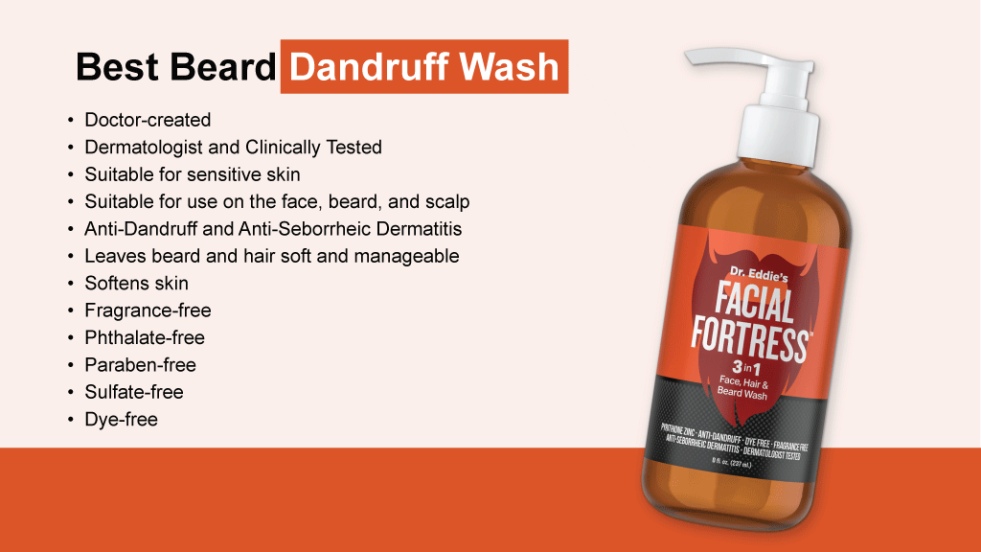
What if I tell you about a shampoo that can be used on the face, hair, and beard? The 3-in-1 hair, face, and beard wash by Facial Fortress is specifically designed for individuals with sensitive skin, targeting flakes, scales, itching, and redness on the scalp and face associated with seborrheic dermatitis.
This shampoo is free from harsh chemicals and contains natural extracts. Here are more of the unique qualities of Facial Fortress:
- Doctor-created
- Dermatologist and Clinically Tested
- Suitable for sensitive skin
- Suitable for use on the face, beard, and scalp
- Anti-Dandruff and Anti-Seborrheic Dermatitis
- Leaves beard and hair soft and manageable
- Softens skin
- Fragrance-free
- Phthalate-free
- Paraben-free
- Sulfate-free
- Dye-free
- Hypoallergenic
- Leaves skin hydrated with natural extracts: licorice root and apple
Skincare Routine for Managing Facial Dandruff
Using harsh products or not properly adhering to a good skincare routine can result in or exacerbate existing dandruff symptoms. There is no universal routine or guidelines that can fit every individual. But these steps will ensure a great skincare routine for men and may provide some relief from dandruff. No matter if you have dandruff on your forehead and face or have an itchy beard, these steps will improve your overall look, giving you a confident personality to shine.
- Gentle Cleansing: Regular cleansing is a must for removing dirt from the face, beard, mustache, and eyebrows. Use a gentle OTC medicated shampoo if you think you are suffering from facial dandruff.
- Proper Moisturizing: Dry skin needs regular moisturizing. If there is dry skin on your face or scalp, your skin needs a good moisturizing cream for the body and face to protect and hydrate it.
- Sun protection and barrier repair: The skin in affected areas can become thin and may require additional protection. Protect the skin from those direct sunrays with at least SPF 30 sunblock with UVA and UVB protection.
When to Seek Medical Help
If nothing works for you even after consistent use and a proper skincare routine, or the symptoms keep worsening, then consult a professional for help. The lack of improvement could be due to an underlying skin issue or a severe case. These are the red flags, and you must contact a professional if you face any of these issues.
- Severe redness, swelling, or irritation
- Patches on the beard are increasing in size or not going away.
- Your skin is bleeding or showing signs of an infection.
- Zero or negligible improvements after using OTC Medicated Shampoos for a couple of weeks
Conclusion
So, can you get dandruff on your face? Of course, Seborrheic Dermatitis can appear anywhere on your body, including on the face. It can affect your beard, eyebrows, ears, nose, chin, and forehead. But it is important to take the right measures to get rid of pesky flakes. Use the anti-dandruff shampoo by Facial Fortress to get rid of the symptoms associated with dandruff on the face. Be cautious and consistent with your skincare routine, and seek professional help if nothing works or the condition persists or worsens.
Recent Post
Frequently Asked Questions
Is facial dandruff contagious?
Can beard dandruff spread to the scalp?
Dandruff is generally linked to the flakiness of the scalp. But Seborrheic Dermatitis on your beard can also affect your scalp and face, even your mustache.
Does diet really affect dandruff?
Can facial dandruff be cured permanently?
How do I get rid of dandruff in my beard?
- Seborrheic Dermatitis vs. Regular Dandruff: What’s the Difference and How to Manage Them - November 17, 2025
- Beard Dandruff and Natural Remedies: Can Aloe Vera, Licorice, and Apple Extracts Help - November 17, 2025
- Top Ingredients to Look For in a Beard Wash If You Have Sensitive Skin - November 12, 2025
